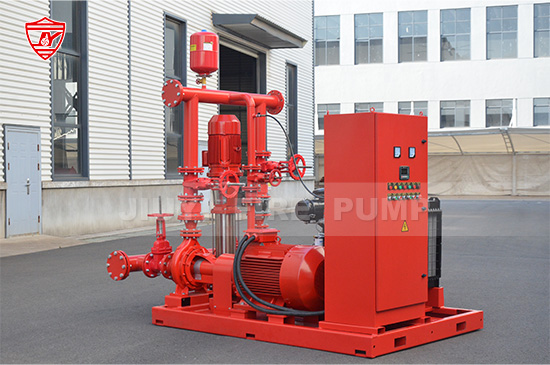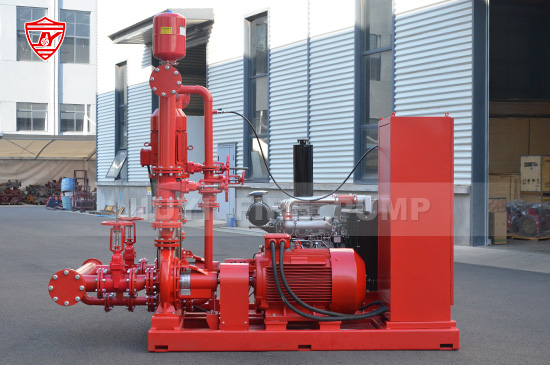In every fire protection system, the fire pump serves as the heart of reliable water supply and pressure delivery. To guarantee its performance, a series of tests are required during manufacturing, installation, and commissioning. One of the most critical among them is the fire pump shutoff head test.
This test verifies that a fire pump can perform safely and effectively under zero-flow conditions — when the discharge valve is completely closed and the pump is operating at maximum pressure. Understanding how this test works, its purpose, and its relationship with NFPA 20 standards is essential for engineers, installers, and facility managers responsible for fire protection systems.

The shutoff head, also called churn pressure or no-flow head, is the maximum pressure a fire pump can develop when water is not flowing through the discharge line. This point occurs at the far left of the fire pump performance curve, representing zero flow but maximum head (pressure).
In real fire protection systems, this condition might occur briefly when the pump starts and before valves open fully or during system testing. While the pump should not run continuously under shutoff conditions, it must withstand the pressure generated without damage or performance failure.
The shutoff head is a vital parameter defined by NFPA 20, UL, and FM Global standards to ensure pump safety and reliability.
Fire pump shutoff head testing serves several key objectives:
Safety Verification – Ensures the pump, motor, controller, and piping can withstand maximum pressure safely without leakage, vibration, or damage.
Performance Validation – Confirms that the fire pump meets its designed head capacity according to the manufacturer’s performance curve and certification requirements.
Regulatory Compliance – Demonstrates conformity to NFPA 20, UL, or FM requirements, ensuring the pump’s rating is accurate and compliant for installation in certified systems.
System Protection – Helps engineers verify that the pressure-relief valve, pressure gauges, and system piping can handle the maximum potential pressure during startup or no-flow conditions.
In short, this test ensures the entire fire pump assembly performs safely even under extreme conditions.
According to NFPA 20: Standard for the Installation of Stationary Pumps for Fire Protection, every fire pump must be tested to verify its performance curve, including the shutoff head, rated flow, and 150% rated flow points.
For most centrifugal fire pumps, NFPA 20 specifies the following limits:
The shutoff head must be not less than 101% and not more than 140% of the rated head at rated capacity.
For vertical turbine fire pumps, slightly different criteria apply depending on the pump type and specific application.
Pressure-relief valves or circulation relief valves must be used when the shutoff pressure exceeds the system’s design limits.
These limits ensure that the pump performs within a safe and predictable pressure range, preventing damage to the fire protection system.
Fire pump shutoff head testing can be conducted both at the factory (by the manufacturer) and at the installation site (during acceptance testing). Below is an overview of the testing process.
Before testing, the following conditions must be met:
The pump is fully assembled and connected to its driver (electric motor or diesel engine).
All pressure gauges are calibrated and installed correctly at the suction and discharge points.
The test piping and valves are arranged according to NFPA 20 requirements.
The discharge valve is closed completely to simulate zero flow. The pump is then started, and suction pressure, discharge pressure, voltage, current, and speed are recorded.
Once the system stabilizes, the discharge pressure represents the shutoff head. This reading is compared against the manufacturer’s rated performance curve to ensure it falls within the acceptable NFPA 20 limits.
The test must be performed briefly—typically no more than a few minutes—to avoid overheating or cavitation, especially for electric motor-driven pumps.
All readings are documented in a test report that includes:
Suction and discharge pressures
Pump speed and motor current
Observed vibration, noise, and temperature
Comparison to rated shutoff head values
If the shutoff head exceeds allowable limits, adjustments such as trimming the impeller or installing a relief valve may be necessary.
Manufacturers conduct factory performance tests on each fire pump before shipment. These tests verify the pump’s performance curve under controlled conditions using calibrated instruments. The results are typically certified by UL or FM for listed fire pumps.
Factory shutoff head tests ensure every unit meets the required performance standards before reaching the customer.
Once installed, the pump undergoes an acceptance test on-site. The goal is to confirm that the pump performs as expected under actual installation conditions. The shutoff head test in the field helps verify that no system restrictions, piping issues, or mechanical defects affect pressure performance.
Both tests are critical for ensuring reliability — the factory test validates design compliance, while the field test ensures operational integrity.
Even well-designed systems can experience issues during shutoff head testing. The most common problems include:
Excessive Pressure – If the shutoff head exceeds 140% of the rated head, it may cause overpressure damage or require a relief valve installation.
Insufficient Pressure – If the pressure is below 101% of the rated head, it could indicate impeller wear, incorrect speed, or suction issues.
Vibration or Noise – Misalignment, cavitation, or air entrainment can cause mechanical instability during the test.
Overheating – Running too long under no-flow conditions can overheat the pump or motor, particularly for electric fire pumps.
Incorrect Gauge Readings – Inaccurate instrumentation can lead to wrong test results, so calibration is critical.
Identifying and addressing these issues during testing helps prevent long-term performance and safety problems.
Fire pump shutoff head testing is not just a one-time factory process — it is a key part of ongoing system maintenance. NFPA 25 (Standard for the Inspection, Testing, and Maintenance of Water-Based Fire Protection Systems) requires regular pump testing to ensure reliability.
Routine testing ensures:
The pump still delivers design pressure after years of service.
Mechanical wear, corrosion, or seal leaks are detected early.
Controllers, valves, and gauges are functioning correctly.
Conducting periodic no-flow tests (weekly or monthly) under supervised conditions also helps verify that the pump starts automatically and develops pressure as expected.
Follow NFPA 20 and NFPA 25 Standards – Always adhere to applicable codes and testing frequency requirements.
Limit Test Duration – Keep the shutoff condition short (1–2 minutes) to prevent overheating.
Monitor All Readings – Record suction, discharge, and voltage data carefully for trend comparison.
Use Calibrated Instruments – Accurate gauges ensure trustworthy test results.
Provide Adequate Ventilation – Especially for diesel-driven fire pumps to avoid overheating.
Engage Qualified Personnel – Tests should be conducted by trained technicians or engineers familiar with fire pump systems.
These practices ensure safe and reliable testing operations without damaging critical fire protection equipment.

Fire pump shutoff head testing is a vital procedure in ensuring the safety, performance, and reliability of fire protection systems. By confirming that a pump can handle maximum pressure under zero-flow conditions, engineers and facility managers can be confident that their system will perform flawlessly in an emergency.